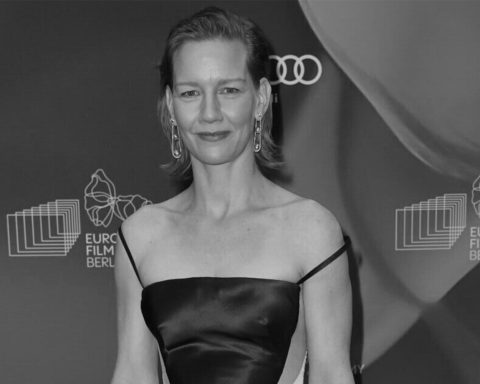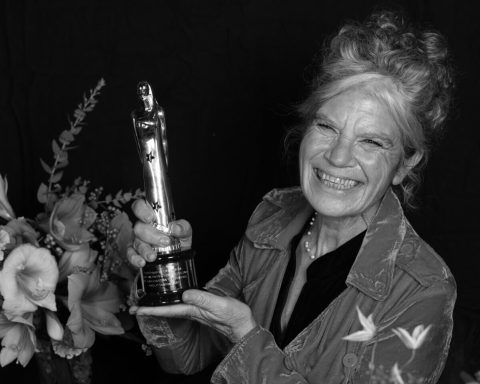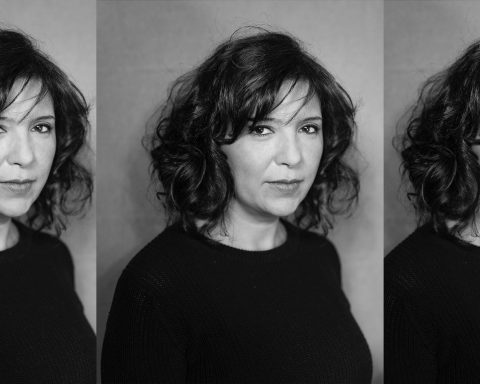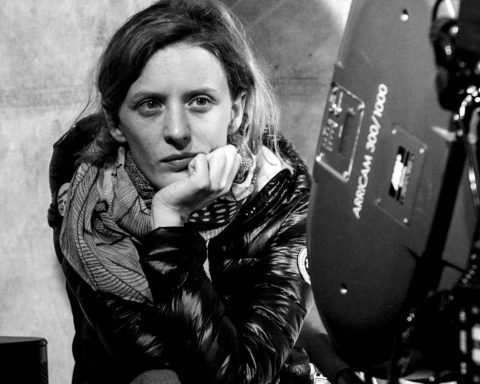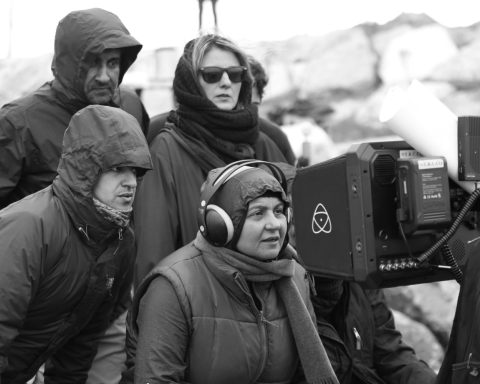Nafiss Nia is a Dutch filmmaker, poet, cultural entrepreneur and public speaker of Iranian descent. She is also the director of Granate Foundation in Amsterdam and in that capacity produces programs such as “Words That Matter,” “The Poetry on the Sidewalk” and “How Do You Dance a Poem.” She studied Cinema in Iran at the Film Faculty of Art University and Modern Persian Literature at the State University in Tehran. In the Netherlands, she studied Scriptwriting at the Film and Television Academy in Amsterdam. In 2019-2020, she followed the program LinC Lage Landen, organized by the University of Utrecht and Business School in Antwerp. LinC is a program for leaders in the arts and cultural sector working in the Netherlands and Flanders. As the founder and director of Granate, Nafiss Nia is committed to promoting greater cultural inclusivity in film and literature. Granate presents the versatility of poetry in combination with film and other disciplines and always in an inclusive setting. The form varies, but the core remains the same: promoting poetry in our midst. The name Granate refers to the pomegranate, a fruit full of jewels that shine individually, but together form a strong fruit. The pomegranate symbolizes the diversity and unity of life. Tara Karajica talks to Nafiss Nia about feminism and film and her debut feature, “That Afternoon,” an intimate character study of two Iranian refugees, two strangers, who communicate through the cracks of a closed door over one afternoon, and may end up being each other’s last hope. The film premiered at the 2023 International Film Festival Rotterdam and is now screening in the Europe! Voices of Women in Film program at this year’s Sydney Film Festival.
How did you become a filmmaker?
Nafiss Nia: I have been a filmmaker since I was fifteen. Very young. I was a member of a young film society in Iran and I also studied Film Directing. When I came to the Netherlands, I also immediately went to study Film, but I chose Scriptwriting because I assumed that writing scripts in another language and taking up this course would speed up the process of learning the language and help me be part of the Dutch film culture as soon as possible. But after graduation, I didn’t get many opportunities to realize my film plans and I was busy writing scripts, journalistic pieces, and so on and I suddenly became poet. I also got recognition as a poet in the Netherlands and have three volumes of poetry published and I still perform as a poet.
How did That Afternoon come about?
N.N.: That Afternoon has a very long history. I myself am a refugee from Iran, so the refugee stories in general are always close to my heart. I also feel involved with the story of the refugees because most of the time the story that we’re told is about how someone flees his or her country; it’s about the situation at the first stage and then you surpass the country and go to another. There are many things about the many dangerous steps you take to just go to a safe country, how you survive the first year of being in a refugee camp and deal with a new situation, a new culture and a new system, but after that, there is no story. From my understanding and my research, there are not many stories about being in a new country and having learned the language, especially, as we know, many refugees are from the Middle East or South America or Africa and European countries as much as they try to help – and they do – at the same time, many former refugees are suffering from the lack of recognition for who they are, and because their education has not really been recognized. Their experiences in many situations are not recognized and they have to begin all over again, from scratch. Every time I told people that I am a filmmaker – because I had made seventeen films when I was in Iran –, I could see they didn’t believe me because I didn’t have anything to show for because all my work was just taken by the Government. But, right now, it’s not that difficult because with the Internet, you always have something somewhere, a link to show, but at that time, that was not possible. When you try to talk about it and discuss that recognition you’re missing, many people consider that kind of discussion ungrateful because you’re safe here, you have a home, you have a job, you have enough money to just survive. So, what are you complaining about? But, as we all know, happiness is not just having a home and money to pay the rent, but it is also being recognized as an equal human being. And, that is actually the basis of the story of That Afternoon. I’ve seen many stories around me of people who are just suffering, really suffering from that lack of recognition. At the same time, people flee their own home, not only because they just have dreams and they want to pursue their dreams, they also want to be part of something. And, the sense of belonging is so important to be able to contribute to your new home.
You turn the restriction of the film’s premise into a source of poetry and it’s inventive. You also make the most of not only the cinematography, but also the framing and the editing. Can you talk about these artistic choices?
N.N.: I am very impressed and inspired by the Japanese writer Haruki Murakami. And, when I read the book Norwegian Wood, I saw there was a connection between two people and although there was a connection, they couldn’t reach each other. I was so fascinated by it and I told myself I’d love to have such two people in my film. In my case, it’s two people who can reach each other and be together, but they don’t have a connection and they try not to have a connection as long as possible. Then, I needed something metaphoric to put between them. And, I suddenly saw a door and I used that. It always stays close and everything happens behind the door. Gradually, it came to me how they can have a conversation and how it is better that one sees the other and the other one not and which one is better. Immediately, I knew that the one with hope should be the one that doesn’t see anything because all she has is her hope and her passion for life and going on and what the other one has is the ability to see, to observe and actually have everything in his house, but at the same time he can’t see. I wanted to play with what you see. Sometimes, you think you can see, but you don’t. Sometimes, you still think you can’t see and you are imprisoned between walls, but you actually see more.
The film plays with two visions that are central to the plot development, but also two perspectives. You we have the space, but you also have their two points of view that are completely different. So, there are many layers from two sides. Can you elaborate on that?
N.N.: My female character has hope, and she has the enormous desire to make something of her life. And, first, she thinks that the only one who can help her is Nassim, another girl, and she doesn’t know her, but gradually we see her growing. When I was looking at the building, I told our location scout: “Think about a corridor, but that corridor has a character.” The corridor is also one of the characters of the film, it just not the arena on its own; it is more than that, because when we are there, we have to have the feeling that there is a character and everybody who’s living there is also part of the corridor. Everybody passes her by. Somebody is curious, somebody asks a question just because they are curious, not because they care. And, at the same time, there are people there, we hear things. There are people who live there, but nobody cares about her destiny. And, she’s all alone, actually. So, I didn’t want to put her in an empty building because it’s so easy to put someone in the middle of the jungle and say: “Oh, you’re alone.” But I wanted her to have to be in a place where we hear things, where we can hear and see that people are living there. There is movement, there is sound, but nobody cares about her. That’s the one thing and the other one is that the boy has everything; he has a beautiful flat, he has a job, but he’s not happy with it. He’s not happy because of the lack of the sense of belonging. He doesn’t think he belongs there or in this new society he is living in. Actually, he is lonelier than she is because although there is nobody who cares about her, she has hope and hope is a big thing. If you have that, you’re not alone.
They’re from the same country, but they have completely opposite perspectives on life. Can you comment on that?
N.N.: People think that every refugee looks like every other refugee or has the same story or the same opinion. Sometimes, the refugees just don’t like each other at all. They can’t help each other because there are not many opportunities for others and it’s threatening for another refugee because you can just come and take their opportunities. It doesn’t happen in my film. But, in real life, it happens because there are not many chances. Sometimes, in case of the young man in there, his past is excruciating and he doesn’t want to talk about it. And, he doesn’t think that anybody else can understand him. Sometimes, we think: “Oh, two refugees – put them together and they can talk about their trauma.” But it’s actually a very naive thought, because they both have their own pain and their own trauma. And, they actually try to live so that they don’t talk, and just pretend. Eventually, they do because they don’t have a choice.
The film is about walls, boundaries, both physical, emotional, and it’s in the culture, the language, the politics and interests. Ultimately, it’s a film about salvation. Can you delve more into that?
N.N.: Yes, everything you have mentioned is in the film and I didn’t want to emphasize that, but I put my thoughts and many other things and, for me, it was like: “I’m going to tell the story and I’m going to tell a story behind that story and if people just get the story, even if it’s only the one on the surface, that is okay because it’s still the story between two people who can embrace each other.” But if you just go and dig deeper and you find another story, it’s also a compliment for me. But, at the same time, despite not having a connection, despite everything, what I actually wanted to tell with That Afternoon is that you can’t manage, you can’t survive without each other. Actually, it’s the message for you, the message for myself, for my brother, my neighbor, for my friends and everybody on the street. Let’s do it together because on our own, we can’t manage, we can’t survive. So, it doesn’t matter how heavy it is, and how many disasters there can be and how exhausting it is sometimes, if we do get together, we can make it lighter.
Roya is youthful, idealistic and very optimistic. How much of you is in her? How do you see her? Can you talk about her?
N.N.: They are both me. When I wrote the story, I knew I would tell my own story because it took me about twenty years to be able to make my first directing debut. And, I knew I wanted to talk about that because I saw many people having the same story. I said: “If I keep it to myself, I am actually also betraying other people because I’m not telling their stories.” And, they are both me but, at the same time, they are not me because I am very optimistic and have hope, but I also experienced a lot of despair, anger and loneliness. What the young man experiences. And, in a way, when I first started, when I gave the script to Hoda Niku and Alin Wishka, my actors, they read it and immediately wrote back: “Oh, my God! Nafiss! I cried and cried because you are telling my story!” And then, my production designer, my makeup artist, even my Oscar-winning editor, Hayedeh Safiyari, sent me a message and said: “You know, I was planning on reading the script during the weekend, but I just took a peek and I couldn’t stay away! You are telling my story!” And, it was very overwhelming to hear that and I’m glad because That Afternoon is not my story anymore. It belongs to other people. To everybody. Actually, everybody who, at a certain moment, experiences hope and despair.
Can you talk about the title, “That Afternoon”?
N.N.: Every everything happens in one afternoon. So, it’s between 12pm and 6pm. And, one afternoon can change your life if you are open to it. Or, sometimes, you are not open, but it happens to you. Many, many of us experience accidents or good opportunities. It happens so fast.
Do you think that the film will have an impact today on the life of refugees and in the way they see themselves, in the way they process their experiences as refugees, in the way other people see them and experience them?
N.N.: I hope it does because I don’t pretend to change the world. I don’t want to, actually. I don’t want to change the world. I want to begin with myself and if I just can make a couple of people just watch the film and think about refugees or think about themselves – how they actually react to people because they can tell their stories, it is likely going to snowball and we can change something. So, my hope is that as many people as possible watch it. It would be wonderful to show it to as many people as possible, and that they recognize that sense of belonging and the desire to have it. It is so human. It doesn’t belong to one ethnicity or one country or one culture. No. Everybody seeks happiness. Everybody wants to have a home and to feel at home wherever they are.
Can you talk about the challenges and the small victories of making this film?
N.N.: I faced quite a few challenges before the film was made. Offering the film plan to the film fund in the Netherlands and convincing them that I could make it, finding a producer, selecting the crew, finding the lead actress – and finding her in South Korea – and then dealing with a low budget and trying to make a film that stood out not only in terms of content, but also visually. Any filmmaker would say they go through the same thing during the process of making a film, but for me it was extra challenging because I was quite unknown in the film industry in the Netherlands. I had no network and no safety net. What I had was a story and a huge passion to make it. The victories I achieved during the whole process are quite a lot. My luck started the moment the film fund believed in my story and ultimately me. From then on, everything started rolling. Before making the film, I wanted to be surrounded by professionals who knew their work well so that I could learn from them and their experiences. That was the very best thing I experienced. I had the best DOP, the best production designer, the best sound man and sound designer, a fantastic editor and composer. And, above all, a producer who was committed, with integrity and worked on the film with a lot of passion.
Are you a feminist? If so, how does it inform your filmmaking?
N.N.: Yes, I am. There are, of course, many, many definitions of feminism, but I am certainly for female power. For many, many centuries, women have pushed away their talent, their power, their thoughts and their opinions. And, I think that it’s time we just let the world see what we can do and if we can’t, we can learn. But yes, I’m a feminist, and I believe in the unlimited power of women. Even in Iran, right now, women – and men – are fighting for their basic human rights empty-handed. They appear without scarves on the streets, which is very dangerous, singing and dancing, and they are making everybody so angry in the Government, so it must be very powerful. I learned feminism from my father. My father was the first feminist in my life – how he approached women, how he talked to us, how he taught us to actually talk to each other, support each other. He was the first feminist in my life.
How do you see the situation of women in film today? How is it in the Netherlands?
N.N.: It looks like in the Netherlands, there are many female executives and female filmmakers, but at the same time, men still have more power, or the last word, more decision-making power, more influence, but there also needs to be more space to experience to be able to find our own style, our own voice. So, there is certainly still work to be done in the Netherlands. The same goes for Iran. The movement Woman_Life_Freedom is powerful there and has an impact on every aspect of life and certainly in Cinema. I see how strong the influence is of well-known actors and filmmakers in support of this movement. And, that’s a good sign because of the knowledge we have and the immediate awareness of it; it makes us also aware of the situation not only in our country, but in many countries and it has gathered enormous support. My first thought is to be able to give women more opportunities in the film industry. We, women, need to share the opportunities, knowledge and network with each other and allow each other the growth and success. And, not with women alone, we also need to make a fist together with men. Together, we can accomplish something big and it is very important to just put our differences aside and focus on what we can accomplish together because I don’t see men as enemies, but as allies, as people we can also learn from and support each other.
Do you have a favorite film by a female filmmaker and a favorite female filmmaker?
N.N.: Oh, yes! I have many, actually! There are so many women filmmakers whose work I find beautiful, memorable and instructive. Jane Campion is one of my favorite filmmakers. Sofia Coppola, also. The Iranian filmmakers Rakhshan Banietemad and Shirin Neshat. From the Netherlands, Marleen Gorris and Urszula Antoniak and, of course, Heddy Honigmann. She is known as the “Queen of Documentary” in the Netherlands. And she’s originally from Peru. But also, like me, she was a refugee. I also like the Lebanese director, Nadine Labaki.
What are your next projects?
N.N.: I am working on my next film. It is very different, but the main theme is also refugees in a totally different light and my female character’s name is also Roya. Roya means “dream.” It’s not like I’m just going to spend my whole life making films about refugees. I have quite a few stories I would like to film, but right now, the fate of refugees is on my mind. And, I want to raise some kind of awareness through my films.
Photo credits: ©Harry Kleine.
This interview was conducted in partnership with:

and







